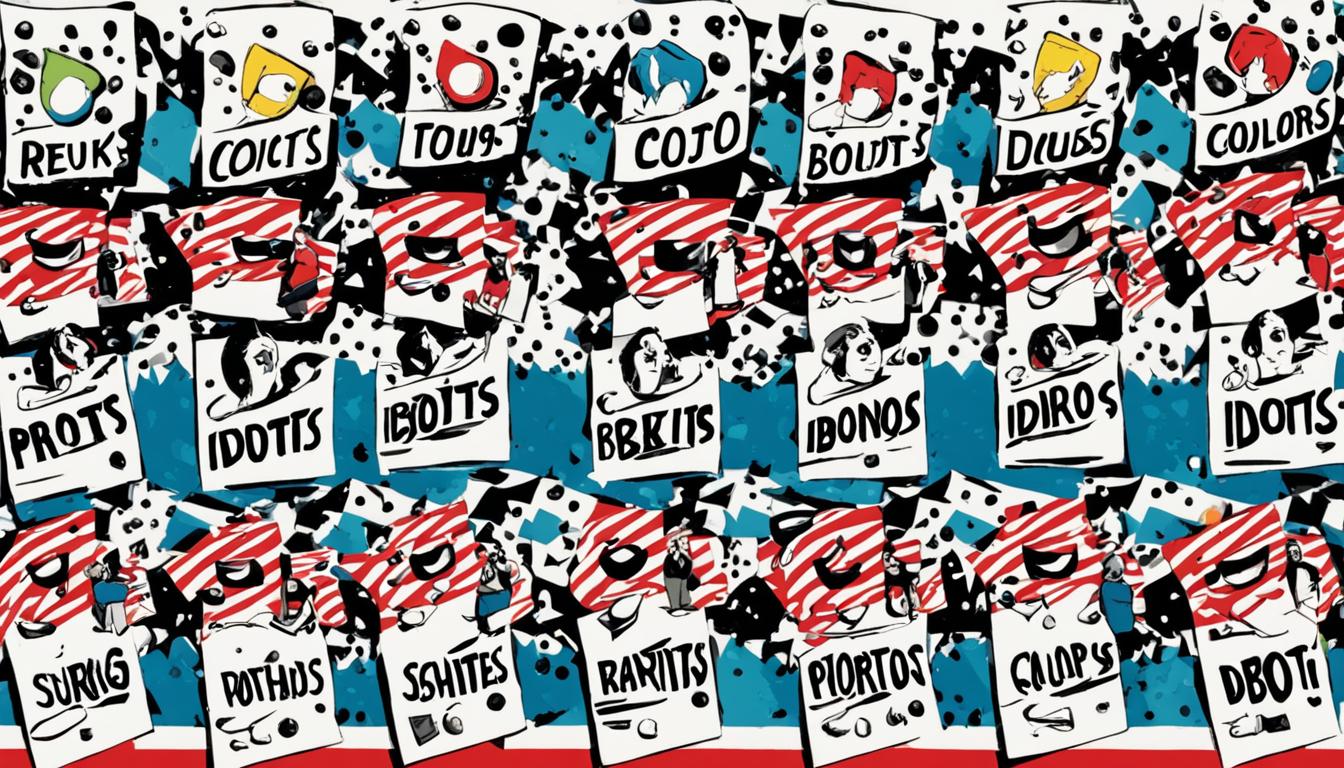Have you ever considered that the color orange is linked to a lively and energetic personality? That’s right! The characteristics of people who are drawn to the color orange are just as vibrant and unique as the color itself.
Imagine this: you wake up on a sunny morning, feeling invigorated and ready to take on the day. Your mind is buzzing with endless ideas and your heart is filled with an undeniable zest for life. You are an Orange personality, driven by creativity, spontaneity, and an unquenchable thirst for adventure.
Whether you’ve always been drawn to the color orange or never really thought much about it, understanding the personality traits associated with this vibrant hue can provide valuable insights into your own behavior and preferences. So, let’s dive into the world of Orange personalities and discover what makes you, well, you!
Key Takeaways:
- Orange personalities are witty, spontaneous, and generous.
- They thrive on fun, variety, and excitement.
- Oranges value freedom and flexibility in completing tasks.
- Teaching Orange personality students requires hands-on learning and creative activities.
- People who love the color orange are warm, extroverted, and friendly.
Characteristics of the Orange Personality
Oranges exude a vibrant energy that sets them apart from the crowd. Known for their ability to juggle multiple projects and tasks, they are unstoppable when faced with challenges. With a penchant for thinking outside the box, oranges bring creativity and innovation to any endeavor. They thrive on imagination and are always ready to celebrate their successes, especially if they involve taking risks.
When given the opportunity to express themselves, oranges shine. They act quickly, relying on their intuition and embracing their unique perspective. Their boldness and eagerness to think outside the box make them excellent problem solvers and natural leaders.
“The essence of the Orange personality lies in their unwavering belief in their abilities to conquer any obstacle and redefine boundaries.” – John Maxwell
Inspiring Action and Embracing Risks
Oranges derive immense satisfaction from tackling challenges head-on. They thrive in environments that allow them to explore new horizons, both personally and professionally. Their boldness and fearlessness enable them to take risks without hesitation, often yielding remarkable results. Orange personalities relish the opportunity to step out of their comfort zones and venture into uncharted territory.
- Embracing Challenges: Oranges are constantly seeking new challenges and novel experiences. They enjoy pushing their limits, utilizing their creativity, and finding innovative solutions.
- Imagination Unleashed: The orange personality traits are closely linked to vivid imaginations. They embrace their creativity without reservation, which often leads to ingenious ideas and unconventional approaches to problem-solving.
- Celebrating Success: Nothing motivates oranges more than celebrating their achievements. They understand the value of their hard work and revel in the sense of accomplishment that comes with overcoming obstacles.
Expressiveness and Out-of-the-Box Thinking
Oranges possess a unique skill set that enables them to excel in various domains. Their innate expressiveness and quick thinking make them charismatic individuals who are capable of captivating audiences. They have an uncanny ability to think on their feet and find innovative solutions to complex problems.
- Expressing Themselves: Oranges thrive when given freedom of expression. They excel in environments that value their unique perspectives and allow them to articulate their ideas without inhibition.
- Intuition and Quick Decision Making: Their ability to make quick decisions based on intuition sets oranges apart. They trust their instincts implicitly and are unafraid to act swiftly.
- Freeing the Mind: The orange personality traits are closely tied to breaking free from convention and exploring uncharted territories. They are unhindered by preconceived notions, allowing their imagination to soar.
Teaching Orange Personality Students
When it comes to teaching orange personality students, it is essential to understand their unique characteristics and tailor the learning experience to their needs. Orange personality students are known for their energetic, spontaneous, and courageous nature. They thrive on hands-on learning and prefer activities that provide visible results.
These students excel in artistic studies, where they can unleash their creativity and engage in expressive forms of learning. They often prefer creative activities over strict desk work, as they enjoy the freedom to explore and experiment with new ideas.
One effective way to engage orange personality students is by providing opportunities for them to be in front of their peers. By showcasing their unconventional processes and expressing their unique perspectives, these students can become valuable learning resources for others.
However, it is crucial to address potential teasing or negative reactions from other students towards their unconventional approach. Creating a supportive and inclusive classroom environment will foster a sense of belonging and understanding.
At times, orange personality students may exhibit disruptive behavior due to their spontaneous nature. It’s important to provide structure and clear boundaries to ensure a productive learning environment for all students.
By harnessing the strengths of orange personality students and understanding their learning preferences, we can create an environment that nurtures their creativity and allows them to thrive.

| Characteristics | Examples |
|---|---|
| Energetic | Constantly seeking new challenges and activities |
| Spontaneous | Thrives on impromptu decision-making and quick thinking |
| Courageous | Unafraid to take risks and embrace new experiences |
| Creative | Excels in artistic studies and enjoys expressing themselves |
| Prefer hands-on learning | Thrive when engaged in tangible, experiential activities |
Embracing the Orange Personality
“Orange personality students bring an infectious energy and creativity to the classroom. By understanding their unique traits and providing tailored support, we can unlock their full potential and cultivate an environment that inspires growth and learning for all.”
Characteristics of Those Who Love the Color Orange
If you find yourself drawn to the vibrant color orange, it says a lot about your personality. People who love the color orange are warm, optimistic, extroverted, and friendly. They radiate positive energy and have a natural ability to uplift those around them. The color orange is associated with enthusiasm, creativity, and joy, and those who resonate with it embody these qualities in their everyday lives.
Just like the color itself, individuals who love orange are bold and assertive. They are not afraid to take charge and pursue their goals with determination. Their outgoing nature makes them excellent communicators and connectors who thrive in social settings. Whether it’s planning get-togethers or organizing events, they enjoy being the life of the party and creating memorable experiences for others.
Orange enthusiasts thrive on human connection and are highly motivated by the opinions and feedback of others. They seek validation and approval from their peers and value the relationships they build. Their open and friendly nature makes them approachable and easy to get along with, attracting a wide circle of friends and acquaintances.
“The color orange symbolizes enthusiasm, creativity, and joy, embodying warmth, optimism, and a zest for life.”
Adventurous and spontaneous, those who love orange find joy in exploring new horizons and embracing physical challenges. They enjoy outdoor activities and seek opportunities to engage in adventurous experiences. Their willingness to take risks often leads to exciting and memorable adventures, fueling their zest for life.
| Positive Traits | Negative Traits |
|---|---|
|
|
Embracing the color orange in your life can bring vibrancy, energy, and a sense of adventure. Whether it’s through your clothing choices, home decor, or the activities you engage in, allowing the color orange to be a part of your world can enhance your overall well-being and inspire those around you.
Deeper Insights into the Orange Personality
We all have unique needs and desires that shape our personalities. When it comes to the Orange personality, their deepest need is to be part of a group and to socialize. They thrive on connections and value acceptance and respect. To truly understand the Orange personality, we need to delve into their craving for regular challenges, both physical and social.
Orange personalities are known for their insatiable curiosity and their desire to constantly push themselves. Whether it’s engaging in physically demanding activities or seeking out social experiences that test their limits, they thrive on the thrill of new challenges. This deep-rooted need for excitement and stimulation drives their actions and shapes their personality.
Orange personalities can sometimes display aloofness, egotism, and self-centeredness when they are in a negative state. It’s important to recognize that this behavior is a manifestation of their frustration or dissatisfaction. By addressing their underlying needs and providing them with positive challenges, we can help them overcome these negative traits and regain their natural zest for life.
Their abdomen-based sense of fear also contributes to their personality. This specific type of fear is rooted in the gut, affecting their decision-making process and risk-taking tendencies. It’s important to understand that this fear is not a sign of weakness but rather a source of motivation and caution.
The Orange personality assessment goes beyond surface-level traits to uncover the deeper motivations and fears that drive individuals. By understanding these insights, we can better empathize and communicate with Orange personalities, allowing us to build more meaningful and fruitful relationships.
Benefits of Embracing the Orange Personality
Embracing the Orange personality comes with its own set of benefits. By incorporating their need for challenges and social interaction, we create an environment that allows Orange individuals to thrive. It’s important to provide them with opportunities for growth, allowing them to express their creativity and take risks. When we support their adventurous spirit and encourage their free-thinking nature, we allow their unique strengths to shine through.
Orange personalities are often considered the life of the party, bringing energy and excitement to social gatherings. They excel in situations that require quick thinking, adaptability, and spontaneity. By leveraging these strengths, we can create vibrant and dynamic social connections that uplift everyone involved.
By recognizing and embracing the Orange personality, we can unlock their full potential and create a more inclusive and diverse community.

| Key Characteristics | Deeper Insights |
|---|---|
| Crave socialization | Orange personalities deeply desire social connections and thrive in group settings. |
| Seek regular challenges | Orange personalities have an innate drive for novelty and excitement, both physically and socially. |
| Can display self-centeredness | When in a negative state, Orange personalities may exhibit ego-driven behavior as a defense mechanism. |
| Gut-based fear | An abdomen-based sense of fear shapes the decision-making process of Orange individuals. |
Tips for Teaching Orange Personality Students
When teaching Orange personality students, we have found that incorporating hands-on and physically engaging activities can be highly beneficial. Orange personalities thrive on collaboration, exploring concepts, and bouncing ideas with others. It’s important to provide them with opportunities to actively participate in their learning process, as this enhances their engagement and enthusiasm.
One effective strategy is to incorporate fidget tools into the classroom environment. These tools can help Orange personality students maintain focus, especially when they are required to remain seated at their desks for extended periods. Fidget tools, such as stress balls or fidget spinners, can provide a physical outlet for their excess energy, allowing them to concentrate better on the task at hand.
Another useful tip is to teach them about work/life balance and the importance of prioritizing hard work before play. Orange personalities often have a inclination towards immediate gratification and may struggle with delayed gratification. By emphasizing the value of putting in the necessary effort and work before enjoying leisure activities, they can develop a more balanced approach to managing their time and responsibilities.
Cultivating creativity is also essential for Orange personality students. Encouraging their participation in the arts, such as painting, drawing, or drama, allows them to express themselves authentically. Creative activities provide an outlet for their spontaneous and imaginative nature, helping them build confidence and develop their unique talents.
To summarize, when teaching Orange personality students, remember to:
- Incorporate hands-on and physically engaging activities
- Provide fidget tools for better focus
- Teach work/life balance and the importance of hard work before play
- Cultivate creativity through participation in the arts
Takeaway:
Understanding the unique learning needs of Orange personality students and implementing tailored teaching strategies can greatly enhance their educational experience. By providing hands-on activities, addressing their need for collaboration, and nurturing their creativity, educators can help these students thrive both academically and personally.

| Teaching Tips for Orange Personality Students | Benefits |
|---|---|
| Incorporate hands-on and physically engaging activities | Enhances engagement and enthusiasm |
| Provide fidget tools for better focus | Helps maintain concentration |
| Teach work/life balance and the importance of hard work before play | Promotes a balanced approach to time management |
| Cultivate creativity through participation in the arts | Allows self-expression and builds confidence |
Managing Orange Personality Traits
When it comes to managing Orange personality traits, it’s important to maintain structure, show understanding, and be patient during challenging moments. Those with an Orange color personality may exhibit impulsive behaviors, break rules, or act out when under stress. As educators, parents, or colleagues, we can provide the support and reassurance they need to navigate these situations. By offering a safe environment and reminding them that things will return to normal once they calm down, we can help them manage their emotions more effectively.
It’s worth noting that Orange personalities can become forceful and domineering when stressed. However, drawing attention to their reactions may lead to embarrassment or further escalations. Instead, we can offer them space and time to process their emotions, allowing them to regain composure. By recognizing their need for autonomy and flexibility, we can create an environment where their unique traits can thrive.
“Understanding and managing the Orange personality requires a delicate balance of guidance and respect for their individuality.” – Dr. Anna Reynolds
By acknowledging and appreciating the strengths of Orange personalities, we can effectively manage their vibrant energy and spontaneous nature. Let’s explore some key strategies for supporting and nurturing individuals with an Orange color personality:
- Create clear boundaries and expectations to provide structure and guidance.
- Encourage open communication to foster understanding and address any concerns or frustrations.
- Offer opportunities for hands-on learning and interactive experiences to engage their creative and adventurous spirits.
- Provide outlets for self-expression, such as artistic projects or physical activities.
- Teach them coping mechanisms for managing stress and impulsivity, such as deep breathing exercises or mindfulness techniques.
In summary, managing Orange personality traits requires a balance of structure, understanding, and patience. By embracing their unique characteristics, we can create a supportive environment that allows these individuals to thrive. Let’s celebrate their energetic and spontaneous nature while providing guidance and tools for effective self-management.
| Advantages of Managing Orange Personality Traits | Challenges of Managing Orange Personality Traits |
|---|---|
| Energetic and enthusiastic, bringing energy to team dynamics | Potential for impulsive decisions or breaking rules |
| Quick thinking with the ability to come up with creative and innovative solutions | Possibility of becoming forceful and domineering when under stress |
| Out-of-the-box thinkers who excel in adapting to new challenges | Emotional outbursts or unpredictable reactions |

Image: Understanding the traits and characteristics of individuals with an Orange personality can help us better support and manage their unique needs.
The Color Orange and Relationships
When it comes to relationships, individuals with a preference for the color orange have a distinct personality that sets them apart. They embody a free-spirited nature and often resist being tied down by commitments and obligations. Their unique outlook on life is shaped by their gut instincts and a deep attraction to adventurous experiences.

Those who identify with the color orange find joy in being physically active and actively seek outdoor activities that provide a sense of freedom and exploration. They thrive in environments that offer novelty and excitement.
However, their free-spirited nature can sometimes manifest as difficulty with commitment. Individuals drawn to the color orange are known for their unpredictable and inconsistent nature in relationships. This stems from their desire for continuous variety and their natural inclination to embrace change.
To better understand the meaning of orange in personality, it is important to consider its symbolism. Orange represents enthusiasm, warmth, and energy. These qualities are reflected in the personality traits of those who resonate with this vibrant hue. Their natural zest for life lends itself to engaging and passionate partnerships.
Despite the challenges that come with their fear of commitment, individuals who love the color orange bring a unique sense of vibrancy and spontaneity to relationships. They are known for their ability to infuse fun and excitement into shared experiences. Their optimistic outlook and friendly demeanor make them easy to connect with and genuine pleasure to be around.
Quotes
“The color orange, with its warm and energetic characteristics, truly embodies the vitality and adventurous spirit of those drawn to it.”
The Color Orange in Relationships: Pros and Cons
| Pros | Cons |
|---|---|
| Spontaneity and excitement | Difficulty with commitment |
| Warmth and friendliness | Inconsistency and unpredictability |
| Adventurous and lively | Reluctance to be tied down |
Exploring a relationship with someone who embodies the orange personality traits can be a thrilling journey filled with unforgettable moments and an abundance of energy. However, it’s important to navigate their inclination for change and their desire for variety. Communication and understanding play crucial roles in building a strong and fulfilling connection with an individual who resonates with the color orange. Embrace the adventure and be open to the excitement that awaits.
Conclusion
Discovering your personality color and understanding its traits and symbolism can provide valuable insights into your own behavior and preferences. The color orange represents a vibrant and energetic personality, characterized by optimism, creativity, and a love for socializing. By recognizing and embracing these traits, individuals can navigate relationships and work environments more effectively.
The personality color test enables us to gain a deeper understanding of ourselves and the motivations behind our actions. The color orange signifies a zest for life, a willingness to take risks, and an inherent need for both freedom and variety. People with an orange personality are known for their spontaneous nature, boldness, and ability to find joy in the present moment.
Embracing the color orange in our lives can spark our creativity, encourage us to step out of our comfort zones, and inspire a sense of adventure. Whether it’s adopting orange accents in our environments or incorporating orange-themed activities into our routines, we can harness the power of this color to energize and uplift our spirits. So, take the personality color test and discover the vibrant world of orange that awaits!
FAQ
What are the characteristics of the Orange personality?
The Orange personality is known for being witty, spontaneous, generous, optimistic, eager, and bold. They thrive on fun, variety, stimulation, and excitement. Oranges value freedom to act and need flexibility in completing tasks.
How do Orange personality students learn best?
Orange personality students excel in hands-on learning and benefit from visible results. They prefer creative activities over strict desk work and thrive on collaboration and exploring concepts with others.
What are the characteristics of those who love the color Orange?
People who love the color Orange are warm, optimistic, extroverted, and friendly. They enjoy socializing, planning social events, and thrive on human connection. They are often adventurous and enjoy outdoor activities and physical challenges.
What is the deepest need of an Orange personality?
The deepest need of an Orange personality is to be part of a group, to socialize, and be accepted and respected. They crave regular challenges in their life, whether physical or social.
How should I manage Orange personality traits?
Managing Orange personality traits involves maintaining structure, showing understanding, and being patient during challenging moments. Offering support and reassurance when they are stressed can help them calm down and return to normal.
What should I know about the Color Orange and relationships?
Those with a preference for the color Orange may have a free-spirited nature and a reluctance to be tied down. They live based on their gut instincts and can be unpredictable and inconsistent in relationships.
What is the significance of the Color Orange in personality?
Discovering your personality color and understanding its traits and symbolism can provide valuable insights into your own behavior and preferences. The color Orange represents a vibrant and energetic personality, characterized by optimism, creativity, and a love for socializing.
How should I teach Orange personality students?
When teaching Orange personality students, it’s beneficial to incorporate hands-on and physically engaging activities. They thrive on collaboration, exploring concepts, and bouncing ideas with others. Providing fidget tools can help keep their focus while offering structure can curb disruptive behavior.
Why is the Orange color significant in personality assessment?
The Orange color represents a personality that is energetic, spontaneous, and courageous. It is associated with qualities such as creativity, risk-taking, and out-of-the-box thinking.
What is the meaning of the Orange color in the context of personality?
The Orange color in personality reflects a vibrant, adventurous, and lively individual who enjoys socializing, physical activities, and taking risks.
Felicity, our Author, pens in-depth articles and guides that delve into the heart of personal discovery. Her narrative-driven approach weaves together theory, practice, and personal anecdotes, making the journey of self-exploration both relatable and inspiring. Felicity’s contributions help illuminate the path for those seeking a deeper understanding of themselves and their relationships.










